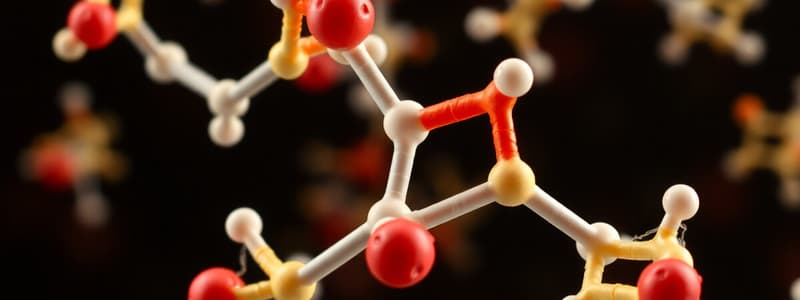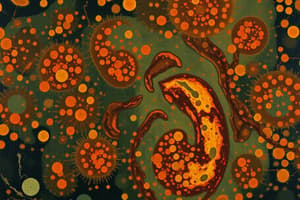Podcast
Questions and Answers
What is the mechanism of action for competitive antagonists?
What is the mechanism of action for competitive antagonists?
- They bind to an allosteric site on the receptor.
- They permanently inactivate the receptor.
- They enhance the effect of endogenous ligands.
- They compete with agonists for the same binding site on the receptor. (correct)
What does the IC50 value signify in pharmacology?
What does the IC50 value signify in pharmacology?
- The amount of antagonist required to inhibit a process by 25%.
- The concentration needed to achieve full activation of the receptor.
- The concentration at which 50% of the biological effect is inhibited. (correct)
- The potency of the agonist in evoking a response.
How do noncompetitive antagonists differ from competitive antagonists?
How do noncompetitive antagonists differ from competitive antagonists?
- They bind to an allosteric site, not altering agonist binding. (correct)
- They increase the efficacy of the agonist.
- They enhance receptor activation.
- They bind to the same site as the agonist.
In what context can IC50 values be compared?
In what context can IC50 values be compared?
What is the primary result of inert antagonists acting on the receptor?
What is the primary result of inert antagonists acting on the receptor?
What does EC50 represent in pharmacology?
What does EC50 represent in pharmacology?
Why is a logarithmic plot preferred for visualizing concentration-response relationships?
Why is a logarithmic plot preferred for visualizing concentration-response relationships?
Which of the following statements is true regarding the Emax of different agonists?
Which of the following statements is true regarding the Emax of different agonists?
When comparing agonists A, B, and C, which aspect is different among them?
When comparing agonists A, B, and C, which aspect is different among them?
How is the potency of a ligand typically evaluated in pharmacology?
How is the potency of a ligand typically evaluated in pharmacology?
In the context of concentration-response curves, what does the term 'efficacy' refer to?
In the context of concentration-response curves, what does the term 'efficacy' refer to?
What is the primary purpose of plotting concentration-response curves?
What is the primary purpose of plotting concentration-response curves?
What characteristic of an agonist's response is evaluated using concentration-response curves?
What characteristic of an agonist's response is evaluated using concentration-response curves?
What does differing EC50 values among agonists indicate?
What does differing EC50 values among agonists indicate?
What effect does a partial agonist have in the presence of a full agonist?
What effect does a partial agonist have in the presence of a full agonist?
What is the outcome of repeated use of agonists on receptors?
What is the outcome of repeated use of agonists on receptors?
What is typically observed in mammalian systems regarding receptor occupancy and drug response?
What is typically observed in mammalian systems regarding receptor occupancy and drug response?
What does the term 'spare receptors' refer to?
What does the term 'spare receptors' refer to?
What characterizes the concentration-response curve when an inverted U-shape is observed?
What characterizes the concentration-response curve when an inverted U-shape is observed?
Why might increasing the dose of an agonist be necessary?
Why might increasing the dose of an agonist be necessary?
What typically occurs when all receptors are occupied by an agonist?
What typically occurs when all receptors are occupied by an agonist?
What is indicated by the term 'amplification of efficacy' in pharmacology?
What is indicated by the term 'amplification of efficacy' in pharmacology?
In receptor pharmacology, what does receptor desensitization imply?
In receptor pharmacology, what does receptor desensitization imply?
What is a consequence of having spare receptors in a system?
What is a consequence of having spare receptors in a system?
What does the Kd value represent in pharmacology?
What does the Kd value represent in pharmacology?
In autoradiography, what is the purpose of exposing tissue to a radiolabelled ligand?
In autoradiography, what is the purpose of exposing tissue to a radiolabelled ligand?
Which characteristic describes antagonists in pharmacology?
Which characteristic describes antagonists in pharmacology?
What does a concentration-response curve typically measure?
What does a concentration-response curve typically measure?
What is the main limitation of binding studies in pharmacology?
What is the main limitation of binding studies in pharmacology?
Which type of agonist produces a maximal response in biological tissue?
Which type of agonist produces a maximal response in biological tissue?
How are competitive antagonists different from non-competitive antagonists?
How are competitive antagonists different from non-competitive antagonists?
In pharmacology, what does the term 'max effect' refer to?
In pharmacology, what does the term 'max effect' refer to?
What can be inferred from a ligand that is characterized as a partial agonist?
What can be inferred from a ligand that is characterized as a partial agonist?
What contributes to the specificity of ligand binding to receptors?
What contributes to the specificity of ligand binding to receptors?
Which of the following statements is true regarding endogenous and exogenous ligands?
Which of the following statements is true regarding endogenous and exogenous ligands?
In radioligand binding assays, which component of binding is characterized as not saturable?
In radioligand binding assays, which component of binding is characterized as not saturable?
What is required for a ligand in order to be used in a radioligand binding assay?
What is required for a ligand in order to be used in a radioligand binding assay?
What type of forces are involved in the binding of ligands to receptors?
What type of forces are involved in the binding of ligands to receptors?
Which aspect is true regarding the interaction between a ligand and a receptor post-binding?
Which aspect is true regarding the interaction between a ligand and a receptor post-binding?
The concept of specific binding in ligand-receptor interactions is best described as:
The concept of specific binding in ligand-receptor interactions is best described as:
Flashcards
Ligand-receptor binding
Ligand-receptor binding
The binding of a ligand to its receptor is a specific interaction that depends on the shape and chemical properties of both molecules.
Endogenous Ligands
Endogenous Ligands
Ligands produced naturally by the body, like neurotransmitters.
Exogenous Ligands
Exogenous Ligands
Ligands that are man-made or modified versions of naturally-occurring ligands.
Multiple Interaction Points
Multiple Interaction Points
Signup and view all the flashcards
Ligand-receptor binding cooperativity
Ligand-receptor binding cooperativity
Signup and view all the flashcards
Radioligand Binding Assay
Radioligand Binding Assay
Signup and view all the flashcards
Nonspecific Binding
Nonspecific Binding
Signup and view all the flashcards
Kd (Dissociation Constant)
Kd (Dissociation Constant)
Signup and view all the flashcards
Autoradiography
Autoradiography
Signup and view all the flashcards
Biological Response or Effect
Biological Response or Effect
Signup and view all the flashcards
Agonist
Agonist
Signup and view all the flashcards
Antagonist
Antagonist
Signup and view all the flashcards
Competitive Antagonist
Competitive Antagonist
Signup and view all the flashcards
Non-Competitive Antagonist
Non-Competitive Antagonist
Signup and view all the flashcards
Concentration-Response Curve
Concentration-Response Curve
Signup and view all the flashcards
Dose-Response Curve
Dose-Response Curve
Signup and view all the flashcards
Emax
Emax
Signup and view all the flashcards
EC50
EC50
Signup and view all the flashcards
Logarithmic Concentration-Response Curve
Logarithmic Concentration-Response Curve
Signup and view all the flashcards
Comparing Drug Potency
Comparing Drug Potency
Signup and view all the flashcards
Efficacy
Efficacy
Signup and view all the flashcards
Affinity
Affinity
Signup and view all the flashcards
Kd
Kd
Signup and view all the flashcards
IC50 Value
IC50 Value
Signup and view all the flashcards
Inhibitory Effect of Antagonist
Inhibitory Effect of Antagonist
Signup and view all the flashcards
How do inert antagonists produce behavioural responses?
How do inert antagonists produce behavioural responses?
Signup and view all the flashcards
Spare Receptors
Spare Receptors
Signup and view all the flashcards
Maximal Effect
Maximal Effect
Signup and view all the flashcards
Partial Agonist
Partial Agonist
Signup and view all the flashcards
Inverted U-Shaped Curve
Inverted U-Shaped Curve
Signup and view all the flashcards
Tolerance
Tolerance
Signup and view all the flashcards
Functional Antagonist
Functional Antagonist
Signup and view all the flashcards
Receptor Desensitization
Receptor Desensitization
Signup and view all the flashcards
Hyperbolic Relationship
Hyperbolic Relationship
Signup and view all the flashcards
Amplification of Efficacy
Amplification of Efficacy
Signup and view all the flashcards
Study Notes
Neuropharmacology I
- Neuropharmacology is the study of drugs affecting the nervous system
- Learning outcomes include defining ligands and binding, types of agonists and antagonists, concentration-response relationships (affinity, efficacy, potency), spare receptors and their role in ligand efficacy, and selectivity.
- A ligand is any chemical that binds to a receptor.
- A receptor is a cell or assembly of molecules involved in chemical signaling within and between cells.
- Ligand binding to receptors involves 3D shape and physical forces (hydrophilic/hydrophobic, charge, van der Waals, electrostatic, covalent).
- Binding can involve multiple interaction points and shape changes.
- Endogenous ligands are naturally produced by the body (e.g., neurotransmitters).
- Exogenous ligands are modified or designed in a lab, and are usually designed to change properties.
- Radioligand binding assays quantify ligand binding to receptors in tissues.
- A ligand is radiolabeled and incubated with tissue; washing removes unbound ligand; radioactive atoms (e.g., 3H, 14C, 125I) are added to the ligand without changing binding.
- The total binding comprises specific binding (saturable) and nonspecific binding (non-saturable).
- Specific binding is the portion binding to the specific receptor.
- Specific binding can be quantified using the dissociation constant (Kd) and the maximal binding (Bmax).
- Kd is the ligand concentration at which half the receptors are occupied.
- Bmax is the maximal total binding observed.
- Radioligand binding assays can create images of the ligand binding to specific sites in a tissue or brain (autoradiography).
- Binding studies only describe the physical relationship between a drug and its target.
- Understanding biological responses to drugs is important
- Agonists, in simple terms, are ligands that either produce or evoke responses in biological tissue
- Different types of agonists include full, partial, and inverse.
- Antagonists do not have their own effect but can block effects of agonists. Antagonists can be competitive or non-competitive
- Concentration-response curves plot biological responses (in vitro or in vivo) against drug concentration.
- EC50 is the effective concentration that elicits 50% of the maximum response.
- Emax is the maximal response achievable.
- Logarithmic plots aid in determining potency (EC50) of ligands.
- Potency can be compared for multiple agonists
- Efficacy is how potent the maximum response will be.
- Partial agonists produce a smaller response compared to full agonists.
- In the presence of full agonist, partial agonists act as functional antagonists.
- Repeated use of agonists may lead to desensitization (tolerance).
- Spare receptors can produce maximal responses with less than maximal receptor occupancy.
- Agonist efficacy/potency is amplified by intracellular pathways.
- Rank order of efficacy is 3 > 2 > 1 (for example)
- Inverted U-shaped concentration-response curves exist for certain agonist actions.
- Competitive antagonists bind to the same binding site as agonists; increasing agonist concentration can overcome the antagonist effect.
- Non-competitive antagonists bind to different sites on the receptor than agonists and alter the receptor's configuration which reduces maximal response.
- IC50 measurements for antagonists can quantitatively determine the effect on the biological response and can be used for comparison between tissues.
- Ligands (agonists and antagonists) can have varying selectivity for specific receptors.
- Neuropharmacology study materials include textbooks on psychopharmacology, molecular neuropharmacology, and pharmacology.
- A ligand can act as a functional antagonist if it reduces the maximum response of a full agonist when working on the same receptor.
Studying That Suits You
Use AI to generate personalized quizzes and flashcards to suit your learning preferences.
Related Documents
Description
This quiz explores the mechanisms of action for competitive and noncompetitive antagonists in pharmacology. Participants will learn about the significance of IC50 values and the effects of inert antagonists on receptors. Test your understanding of these fundamental concepts in drug interactions.




